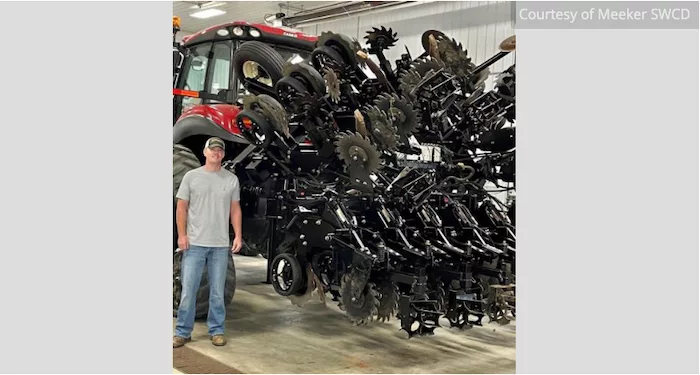Minnesota strip-tiller Jonathan Slinden has made a successful transition to a strip-till system and cover crops with help from local and federal cost-sharing programs.
Slinden, who farms in the Grove City, Minn. area, had been interested in conservation practices, reduced tillage and cover crops for a while, reports Farm Progress, but financial and logistical challenges delayed his adoption of the practices. He reached out to Meeker Soil & Water Conservation District (SWCD) and the USDA Natural Resource Conservation Service (NRCS) for help, and cost-sharing programs through both organizations helped Slinden implement strip-till and cover crops with less financial risk and a better chance at early success.
Slinden received $6,000 through the NRCS Environmental Quality Incentives Program and put it toward the purchase of his 12-row strip-till bar. He says strip-till reduces the number of tillage passes he has to make, as well as lowers his fuel and fertilizer costs.
Last year, Slinden strip tilled about 700 acres – about 70% of his total acres. He strip-tilled soybean stubble going into corn and applied anhydrous ammonia at the same time during the fall. He says it’s a little time-consuming with a 12-row rig, but he believes in the practice.
Slinden hopes to convert all of his acres to strip-till or minimum tillage and diversify his crop rotation using cover crops. Most of his land is rolling hills with coarse soils on the hilltops and rich, black soils in the dips.
2022 marked Slinden’s 6th year using cover crops. The cost-share program through Meeker SWCD covered a maximum of 40 acres of cover crops per year for the first 3 years, and Slinden received funding for an additional 40 acres through federal cost-share under the Conservation Stewardship Program starting in his 2nd year of cover cropping. In 2021, a $5,000 grant allowed him to expand his cover crops to 200 acres.
“What I always tell people is, there’s a lot of free money if you want to try it out — so why not?” Slinden says.
This year, increased costs and limited availability of herbicide forced Slinden to reduce his cover crops to 80 acres of cereal rye. He’ll use CSP cost-share on 40 acres for the final time, but he plans to continue using cover crops on his own in 2023 on 80-100 acres.
The soil health benefits he’s getting from the cover crops are already apparent. Slinden says his wet spots at the bottom of hills are easier to get through, and he can even plant into some of them now. There’s also more tilth to his soils, and they aren’t eroding away.
Although improvements are already starting to become apparent, Slinden says he’s not looking for immediate results. He’s committed to spending decades building organic matter and improving his overall soil health.
“It’s a short-term expense,” he says, “but a long-term gain.”






